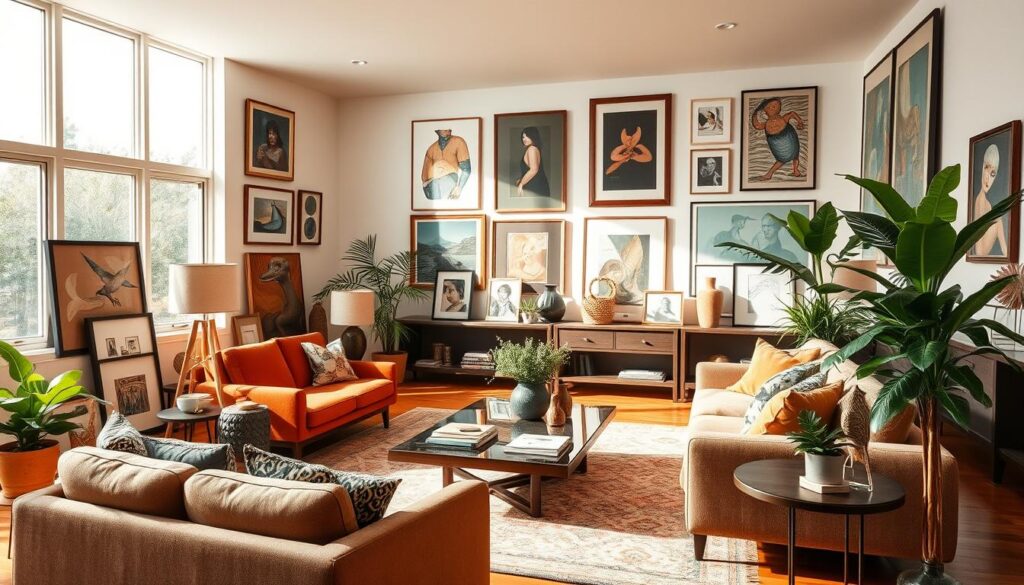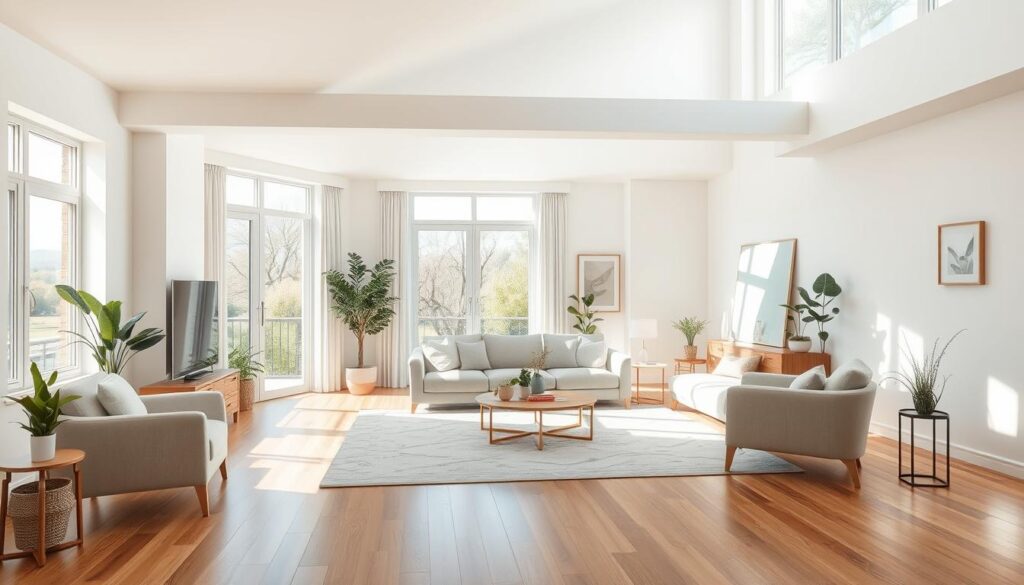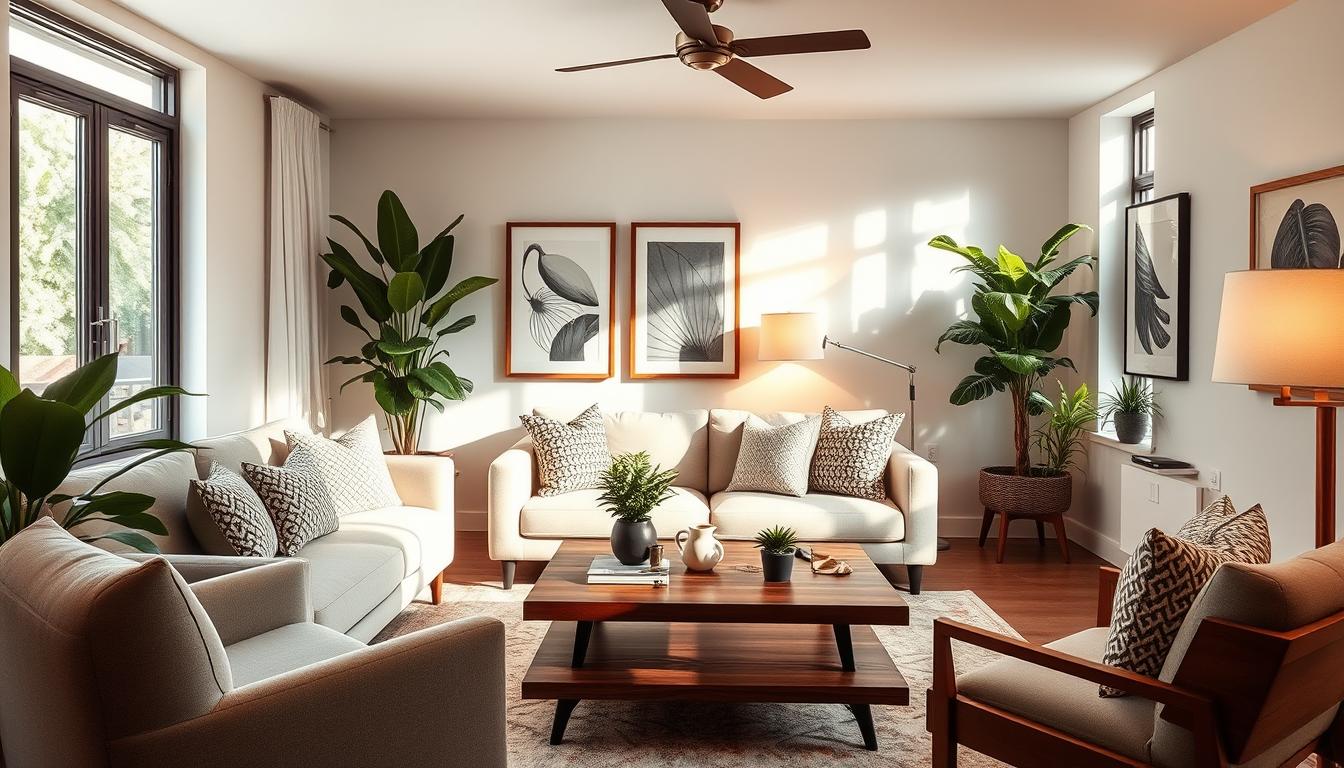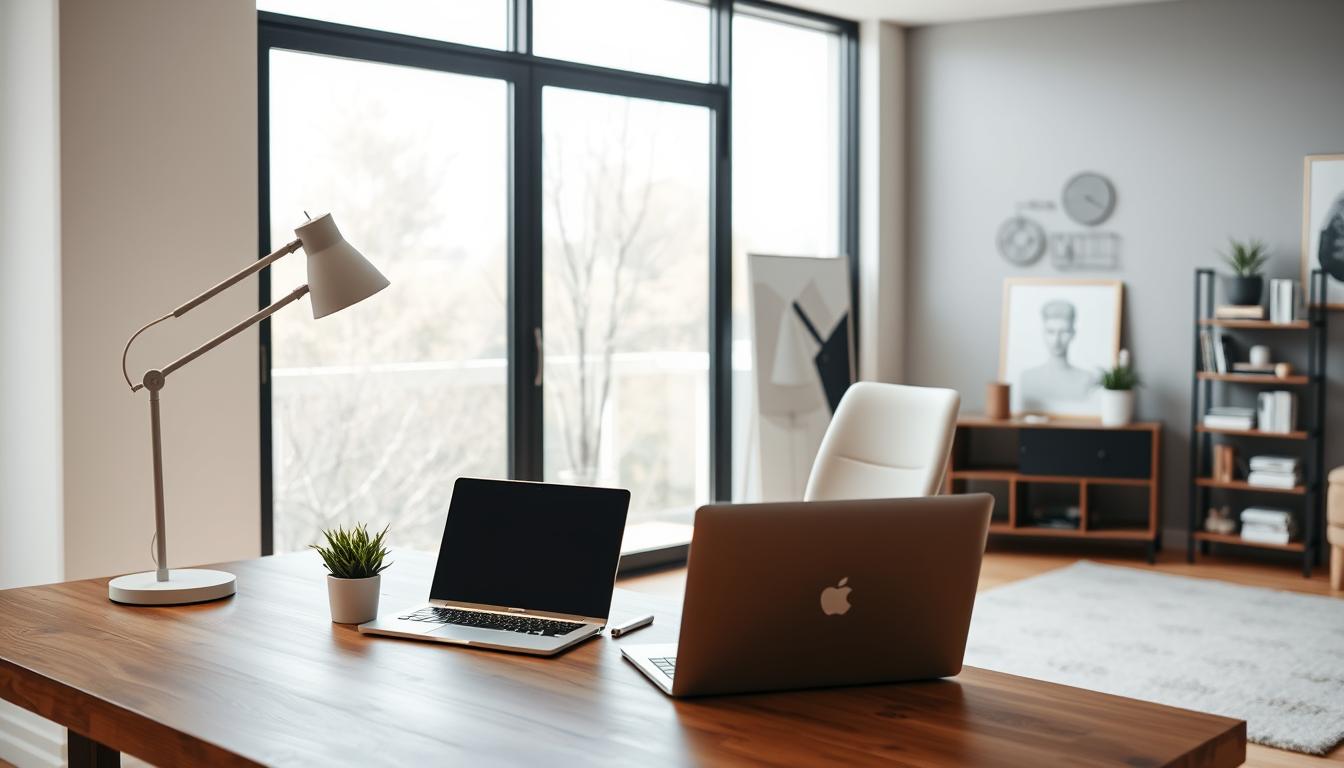Did you know a well-designed space can make you happier and more productive? Creating a stylish space starts with knowing the basics of interior design. We’re excited to share our top tips to turn your space into a cozy haven.
By mixing colors, textures, and furniture, you can make a space that feels just right. Our expert advice will help you plan your space and pick the perfect furniture.
Key Takeaways
- Understand the basics of interior design to create a stylish space
- Balance color, texture, and furniture for a harmonious atmosphere
- Apply space planning techniques to maximize your space
- Choose furniture that reflects your personal style
- Stay up-to-date with the latest home decor ideas
Understanding the Basics of Interior Home Design
To get a modern and trendy interior, knowing the basics is key. This knowledge helps you make a stylish and useful space.
Understanding the basics means knowing a few important things. First, space planning is key. It shapes your room’s layout and flow. It makes sure your space works well for you.
The Importance of Space Planning
Good space planning is the heart of interior design. It’s about measuring your room and furniture. It’s also about figuring out the best way to arrange your furniture.
- Measure your room and furniture to scale.
- Consider the ‘traffic path’ in your room.
- Use multi-functional furniture to maximize space.
Color Theory and Its Impact
Color theory is big in setting your home’s mood. Different colors can make you feel different ways.
For example, cool colors like blue and green calm you down. Warm colors like red and orange make you feel more energetic.
Selecting the Right Furniture
Picking the right furniture is crucial for a unified look. It’s not just about looks; it’s also about function and comfort.
- Consider the scale of your furniture in relation to your room.
- Choose materials and textures that complement your design style.
- Invest in quality pieces that will last.
By focusing on these basic interior design elements, you can make a space that’s beautiful and reflects you. It also meets your needs.
Creating a Cohesive Color Palette
A well-designed color palette is key to stylish home interiors. It involves picking a few core colors that complement each other. This creates a harmonious atmosphere in your living space.
To get a cohesive look, understanding color theory is crucial. It shows how colors interact. When planning your living room decor, think about the mood you want to create.
Choosing a Dominant Color
Start by picking a dominant color. This color will set the room’s tone and should reflect your style. Also, consider the natural lighting in your room. It can change how the color looks at different times.
Think about the psychological impact of your dominant color. Blues and greens can calm a space, while yellows and oranges can energize it.
Complementary and Accent Colors
After picking your dominant color, choose complementary and accent colors. Complementary colors are opposite each other on the color wheel, creating a striking contrast. Accent colors add visual interest and depth to your living room decor.
Using complementary and accent colors well can make your stylish home interiors more interesting. The key is balance; too many colors can make the space chaotic.
By carefully choosing your colors, you can create a cohesive palette. This will enhance your home’s look and make it welcoming.
Maximizing Natural Light in Your Home
Natural light can change how your home feels. It makes spaces brighter and more welcoming. With a few simple steps, you can let more natural light in. This is great for your bedroom or kitchen during a remodel.
Window Treatments that Work
The right window treatments can really help with natural light. Sheer curtains or blinds with adjustable slats are top picks. They let you control the light and keep your privacy.
In bedrooms, use blackout curtains for better sleep. For kitchens, choose easy-to-clean, moisture-resistant treatments.
Reflective Surfaces to Consider
Adding reflective surfaces can also boost natural light. Mirrored furniture or glossy finishes on surfaces reflect light. This makes rooms feel brighter and more open.
When remodeling your kitchen, think about glossy tiles or metallic accents. They help reflect light and make the space feel larger.
The Right Placement of Mirrors
Mirrors are a simple way to increase natural light. Place a mirror opposite a window to reflect light. This makes rooms feel bigger and brighter.
This trick works well in small spaces or areas with little natural light. It’s great for hallways or bedrooms without direct sunlight.
By using the right window treatments, reflective surfaces, and mirror placement, you can make your home brighter. It will feel larger and more welcoming.
Making the Most of Small Spaces
Living in a small space doesn’t mean you have to give up style or function. With the right design, even the smallest homes can feel big and inviting. We aim to help you use your space better with expert interior designer services.
One key way to do this is by using furniture that does more than one thing. This is where multi-functional furniture shines.
Multi-Functional Furniture
Multi-functional furniture is a big help for small spaces. Items like storage ottomans, sofa beds, and coffee tables with storage can cut down on clutter. For example, a storage ottoman can be a footrest, extra seat, and storage all in one.
When picking multi-functional furniture, think about what your space needs. Choose items that fit your lifestyle.
Clever Storage Solutions
Along with multi-functional furniture, smart storage is key for a tidy home. Use wall-mounted shelves, under-bed storage, and hidden spots to keep things organized. These tricks help keep your belongings out of sight, making your space feel bigger and calmer.
By mixing multi-functional furniture with smart storage, you can create a beautiful and useful home. These tips work for any small space, whether it’s an apartment or a small house. For personalized advice, talk to professionals who offer interior designer services to fit these ideas to your home.
Incorporating Textures for Depth
Adding texture to your home decor can instantly elevate the space, making it feel more layered and interesting. Texture plays a significant role in interior design, as it can add depth and visual appeal to a room.
One of the simplest ways to incorporate texture into your home is through soft furnishings. These include throw blankets, rugs, and pillows, which not only add warmth but also create a cozy atmosphere. When choosing soft furnishings, consider the material, color, and pattern to ensure they complement your existing decor.
Soft Furnishings and Their Roles
Soft furnishings play a crucial role in adding texture to a room. For instance, a plush area rug can add a layer of warmth underfoot, while velvet pillows can introduce a luxurious feel. The key is to mix different textures that work well together, creating a harmonious balance.
When selecting soft furnishings, it’s essential to consider their role in the overall aesthetic of the room. For example, a chunky throw blanket can add a rustic touch, while silk curtains can bring in an element of elegance.
Mixing Materials for Visual Interest
Mixing different materials is another effective way to add texture and visual interest to your space. Combining materials like wood, metal, and glass can create a dynamic and engaging environment. For instance, a wooden coffee table paired with metal accents and glass vases can add layers of texture to your living room.
To achieve a modern and stylish interior, it’s crucial to balance different textures. Start by identifying a dominant texture, then complement it with secondary textures that add contrast. For example, in a room with a lot of smooth surfaces, introducing a chunky knit blanket or a woven basket can add a welcome layer of texture.
By thoughtfully incorporating textures through soft furnishings and mixing materials, you can create a rich and inviting space that reflects your personal style and enhances your home decor ideas for a modern interior.
Personalizing Your Space with Art
Adding art to your space can make it truly yours. It can make your home look better and feel more welcoming. By picking art that speaks to you, your space will feel like home.
Selecting Artwork that Speaks to You
Think about what art shows your personality or interests. It could be a painting, photo, or sculpture that means a lot to you. Selecting art that speaks to you connects you, the art, and your home.
To find the right piece, try:
- Exploring local art galleries or exhibitions.
- Visiting artist studios or online marketplaces.
- Getting a custom piece that shows your style or interests.
Gallery Walls: Tips and Tricks
Gallery walls are great for showing off your favorite art and photos. Start by picking a theme or color scheme. This will help all the pieces look good together.
Here are some tips for arranging your gallery wall:
| Arrangement Style | Description |
|---|---|
| Symmetrical | Creates a sense of order and balance. |
| Asymmetrical | Adds visual interest and can make the display more dynamic. |
| Grid | A classic choice that works well for a more structured look. |
To add a final touch, think about the frames. Mixing frame styles adds depth, while the same color creates continuity. Feel free to try different layouts until you find the perfect one.

By choosing the right art and setting up a gallery wall, you can make your space truly yours. Whether you like modern art or classic landscapes, the right pieces can turn your home into a stylish and welcoming place.
The Role of Lighting in Home Design
Lighting in home design is more than just turning on the lights. It’s about setting a mood that shows off your style. It changes how a room feels and works, making it key for both living room decor and bedroom design inspiration.
Types of Lighting to Consider
There are many lighting types to use for different effects. You have ambient, task, and accent lighting. Ambient lighting lights up the whole room, letting you see and move around easily. Task lighting focuses on areas where you do things, like reading or cooking.
Accent lighting highlights special parts of a room, like art or details. Using these lights together can make your home feel richer and more welcoming.
Layering Light for Ambiance
Layering light means mixing different lights to create a cozy feel. You can use overhead lights, table lamps, floor lamps, or wall sconces. The goal is to have enough light without it being too bright.
In a living room, mix ambient lighting (like a ceiling light) with task lighting (table lamps) and accent lighting (floor lamps). This makes the room more useful and interesting to look at.
Finding the Right Decor Accessories
The right decor accessories can turn your space into something special. Whether you’re updating your kitchen or need interior designer services, the right pieces matter a lot.
Decor accessories do more than fill empty spots. They add personality and style to your home. It’s key to find a balance between looks and usefulness.
Selecting Statement Pieces
Statement pieces grab your eye and become the room’s centerpiece. These can be bold art, unique vases, or striking lights. Think about the look you want and your space’s style when picking these pieces.
For a modern vibe, choose sleek, simple decor. Traditional styles might call for classic, detailed items.
Balance Between Minimalism and Clutter
Finding the right mix of minimalism and clutter is important. Too few items can make a room feel empty. Too many can cause clutter and overwhelm.
Start with a few standout pieces and add simpler items to balance them. This way, your space will look good and feel welcoming.
For example, a bold art piece can be paired with simpler vases and decor. Or, group small items on a tray or shelf for a unified look.
Creating Flow and Movement
Arranging furniture well is key to making your home flow smoothly. A good home design should guide you through it easily. It should look great and work well too.
Think about how people will move through your home. You want paths that are easy and don’t make you squeeze through tight spots. Place furniture to keep paths clear.
Furniture Arrangement Strategies
Getting furniture right is important for a peaceful home. Here are some tips:
- Put furniture away from walls to add depth and flow.
- Use area rugs to mark off different spaces in open areas.
- Don’t block doors or narrow paths with big furniture pieces.
- Make sure your furniture fits the room size.
Using these tips can make your home more enjoyable. It will be better for living and visiting.

Defining Different Areas
It’s important to have different areas in your home. This makes it more functional and purposeful. You can use furniture, lighting, and color to do this.
For example, a sectional sofa can make a seating area. Different lighting can show off a reading nook or dining area.
Tips for Defining Areas:
- Use furniture to set boundaries.
- Change flooring or use rugs to mark spaces.
- Lighting can set the mood in different areas.
By carefully placing furniture and decor, you can make your home feel both big and cozy. This approach to interior home design makes your home look better and work better too.
Using these home decor ideas can really change how your home feels. The goal is to make a space that’s both beautiful and useful.
Sustainability in Interior Design
Making our homes eco-friendly is more than a trend. It’s a key step towards a greener future. As we learn about the environmental effects of our choices, sustainability is shaping modern interiors.
There’s a big move towards green materials and energy-saving designs in interior design. This move cuts down our carbon footprint and makes our homes healthier.
Eco-Friendly Materials
Choosing the right materials is key for sustainable design. We seek out materials that are recycled, recyclable, or sustainably sourced. Some top eco-friendly options include:
- Reclaimed wood
- Bamboo
- Low-VOC paints
- Sustainable textiles
| Material | Benefits | Applications |
|---|---|---|
| Reclaimed Wood | Reduces waste, unique aesthetic | Furniture, flooring |
| Bamboo | Fast-growing, durable | Flooring, cabinetry |
| Low-VOC Paints | Improves indoor air quality | Walls, ceilings |
Energy-Efficient Solutions
Energy efficiency is vital in sustainable design. We can achieve this in several ways, like:
- Using LED lighting
- Installing smart home devices
- Improving insulation
- Selecting energy-efficient appliances
By using these green materials and energy-saving designs, we can make modern interiors that are both stylish and sustainable.
Trends in Interior Home Design
The world of interior design is always changing. New trends can make our homes look amazing. Let’s look at the latest trends to make your home stylish and modern.
Current Color Trends
Colors are key in interior design, setting the mood and look of our homes. Right now, we’re seeing a move towards calming colors. Soft blues and greens are big, bringing a peaceful feel and a connection to nature.
Earth tones like terracotta and sienna are also in, adding warmth. These colors blend well, making your living room look great.
Popular Styles to Consider
Styles are also changing, offering many options. Minimalism is big, with its simple look and few colors. It’s great for those who like a clean, calm space.
Sustainable Design is another favorite, using eco-friendly materials. It’s good for the planet and makes your home special. Adding sustainable touches can make your home unique and eco-friendly.
Keeping up with interior design trends helps you create a home that’s both stylish and personal. It meets your needs and shows off your taste.
Budgeting for Your Interior Home Design Project
When starting an interior home design project, budgeting is key. Whether you’re looking for bedroom ideas, planning a kitchen update, or need interior designer help, setting a budget is crucial.
To use your budget wisely, it’s important to have realistic expectations. You need to know the costs of things like furniture, lighting, and materials. By figuring out what you need most, you can spend your money better.
Practical Budgeting Tips
To get a stylish look without spending too much, look for affordable design choices. For example, you can update old furniture or find cheaper versions of decorative items. This way, you can save money without sacrificing style.
Maximizing Your Budget
Being smart with your spending can help you create a beautiful and useful space. If your budget is tight, talking to interior designers can help you stretch it further. With smart planning, you can achieve your design dreams, whether it’s a new kitchen or a cozy bedroom.


